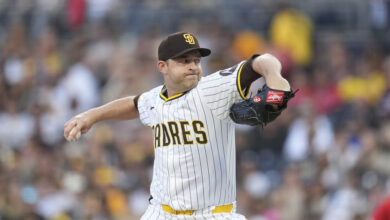
Colin Rea Providing Much Needed Support in Wake of Justin Steele’s Injury
Justin Steele’s injury put a massive wrinkle into the Cubs’ pitching plans, with the team suddenly needing to replace their ace. The lack of offseason acquisitions once again became very prevalent, with Matthew Boyd being the only real starting pitcher brought in. Colin Rea was signed to provide depth and lost the battle for the fifth starter role during spring training, but Steele going down thrust him into the spotlight.
Rea started 27 games for the Brewers in 2024, logging a career high 167.2 innings and posting a 4.29 ERA with 0.9 fWAR along the way. He doesn’t often make the headlines, but he eats innings while quietly being a solid starter. Now the volume is being turned up a bit based on how he’s pitched for the Cubs.
He’s started three games this season and has pitched a total of 18.2 innings in six games. Even if his 0.96 ERA is not sustainable throughout a full year, it’s a sign of changes he’s made since rejoining the Cubs. One of the most notable differences is Rea’s pitch repertoire, which has changed in terms of variety and usage. Rea threw his sinker 31% of the time last season, pairing it with a 20% usage on his four-seam fastball. With the Cubs, the sinker is down to 7% and the four-seam has skyrocketed to 50% of his mix.
Rea’s velocity is up across the board as well, with both fastballs at a career-high 93.7 mph. In addition to shifting focus to the four-seam, Rea has incorporated a firmer slider to give him another breaking ball to pair with his sweeper and curve. He throws the sweeper and slider almost exclusively to right-handed hitters, with the hook reserved for lefties. The effectiveness of those right-on-right breaking balls has him pitching to very pronounced platoon splits after being neutral earlier in his career.
 While his strikeout rate stands at a career-best 25.0%, a lack of hard contact that is translating to better results. Rea’s a 3.7% barrel rate among the best in baseball (84th percentile) and his 35.2% hard-hit rate is down nearly seven points from last year. Rea isn’t getting a lot of chases outside of the zone, but his whiff numbers are up significantly despite a decreased walk rate (3.9%, 91st percentile).
While his strikeout rate stands at a career-best 25.0%, a lack of hard contact that is translating to better results. Rea’s a 3.7% barrel rate among the best in baseball (84th percentile) and his 35.2% hard-hit rate is down nearly seven points from last year. Rea isn’t getting a lot of chases outside of the zone, but his whiff numbers are up significantly despite a decreased walk rate (3.9%, 91st percentile).
Colin Rea's 7Ks. pic.twitter.com/9MToKX6axq
— Rob Friedman (@PitchingNinja) April 25, 2025
His 3.03 xERA supports the notion that he has experienced some good luck, but his 1.51 FIP and .315 BABIP against argue that he’s responsible for creating most of that good fortune. A total overhaul of his pitch mix has driven this strong early performance and having all those pitches in his bag should allow him to adjust further as the season progresses.

